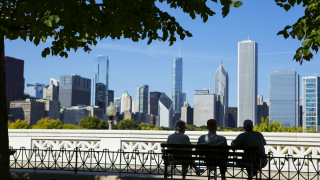
While temperatures were at a brisk 33 degrees at O'Hare International Airport on Thursday morning, it was as cold as 27 degrees just 25 miles away at the National Weather Service's office in Romeoville, according to the NWS.
At Aurora Municipal Airport, 30 miles to the west of O'Hare, temperatures got as low as 24 degrees early on Thursday, marking a stark difference in temperatures between two relatively close locations.
Despite temperatures well into the freezing range in much of the suburbs, O'Hare still has not recorded a freeze since April 17, which was 186 days ago.
According to the NWS, this is due to the urban heat island effect, which exists in Chicago and in other large cities across the world.
Due to concrete and other materials present in building-dense areas, heat is retained and then emitted a night, creating warmer conditions within an immediate urban area as opposed to suburban and rural areas within the region.
This effect is further amplified if the urban area does not have much vegetation, with mid-afternoon temperatures potentially rising 15 to 20 degrees above the temperature of surrounding, more vegetated areas.
A combined lower density of vegetation and higher density of darker materials, most notably dark-colored buildings and asphalt on streets, contribute to a pronounced urban heat island effect in large cities.
Local
While the difference is most frequently noted between city temperatures and suburban temperatures, temperatures can still vary by up to 20 degrees in different neighborhoods of the same city due to the urban heat island effect, according to the NWS.
Recently, the city of Chicago promised to use pandemic relief funds to plant 75,000 trees across the city, predominantly in areas that have below-average tree canopy. However, controversy arose when thousands of trees were found unplanted in a vacant lot just before the season's first frost.
Feeling out of the loop? We'll catch you up on the Chicago news you need to know. Sign up for the weekly Chicago Catch-Up newsletter here.
According to the National Integrated Heat Health Information System, additional measures to mitigate the urban heat island include cool surfaces on roofs, variance in building heights to create shade canyons and the use of more natural ventilation.
More information on the urban heat island effect can be found here.



